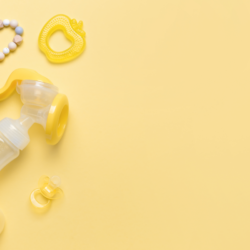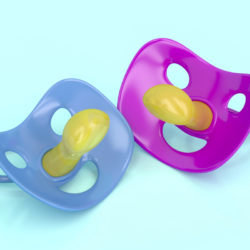Breastfeeding is a natural, learnable act. In modern societies, women do not often see other women breastfeeding, and they do not always have experienced friends or family members from whom they can learn. Some women breastfeed very easily from day one and will never have any problems. However, many run into difficulty or have questions at some point in their path. When this happens, most women need encouragement and wise support to continue breastfeeding successfully.
Why choose breastfeeding ?
The choice of breastfeeding or feeding her baby with breastmilk substitutes is a mother’s decision. However, she cannot make this choice without being properly informed, or if she is not offered the opportunity to breastfeed. Mothers often have bad information from many sources.
A positive approach can increase the incidence and duration of breastfeeding. Women should have a real opportunity to breastfeed, after receiving informed information about breastmilk and substitutes, as well as breastfeeding and bottle-feeding.
Woman’s milk contains hormones, growth factors, cytokines as well as immunocompetent cells, etc., and also has many biological properties. Its composition varies according to the age of the child, its term, and the time of breastfeeding. Breastfeeding helps in particular normal growth.
Breastfeeding is indeed a real cognitive benefit, which it would be a shame not to allow the child to benefit. If it lasts longer than 3 months, exclusive breastfeeding decreases the incidence and severity of digestive, ENT and respiratory infections. Ideally extended for 6 months, exclusive breastfeeding also reduces the risk of allergies in infants at risk (father, mother, brother or sister who is allergic). It is also involved in the subsequent prevention of obesity in childhood and adolescence. In adulthood, breastfed infants have lower blood pressure and cholesterol levels than infants fed formula.
How to get a good latch on your baby ?
Immediately after birth, a healthy baby instinctively seeks to nurse. During the first two hours of life, the baby is alert, active and in fact ready to breastfeed.
Placed on its mother’s belly, a healthy baby born at term is however able to crawl to the breast. The delivery of the placenta is promoted by an increased production of maternal oxytocin, which in turn is stimulated by the baby’s contact with the nipple.
Some babies need two hours or more, and others may not be ready to breastfeed until they wake up from their first sleep. The birth process does not end until the baby changes from placental feeding to breast feeding.
A good latch looks like this :
- The baby’s mouth is wide open and the lips are turned up. The lower lip is particularly upturned, and the baby’s chin touches the mother’s breast.
- The nipple sits far back in the baby’s mouth, with its tip touching the baby’s hard palate / soft palate junction.
- The baby sucks in two simultaneous movements: the lower jaw going up and down and a peristaltic muscle wave that goes from the tip of the tongue backwards. The tongue is sometimesvisible above the lower lip. This action squeezes the milk out, out of the lactiferous sinuses, through the lips to the back of the baby’s mouth.
- The baby sucks briefly at first, but the rhythm changes to a deeper, slower suck when the flow of milk arrives. The baby pauses (swallowing) and these lengthen as the feed continues.
- The baby’s cheeks are plump and not hollowed out.
On the other hand, here is a bad latch :
- The baby sucks or chews only the nipple, with his lips, gums or tongue.
- The mouth is not wide open and the baby sucks on its lips.
- The lips and gums squeeze the nipple instead of the areola.
- The tongue may be misplaced, blocking the nipple protrusion in the baby’s mouth.
- The cheeks are hollow.
Small tips :
- Allow the baby to stay skin-to-skin from birth until he has had time to finish his first feed.
- Interact with your baby at your own pace.
- Let the baby start breastfeeding when he shows he is ready.
How often to breastfeed the baby during the day and for how long ?
Unrestricted breastfeeding is the key to establishing milk supply and preventing many difficulties. This means breastfeeding the baby whenever she shows interest in the breast, day or night. It also means letting the baby finish feeding and letting him leave the breast spontaneously.
What to understand :
Breast milk is digested faster and better than its substitutes. During the first few weeks, most breastfed babies need more feeds than babies fed on substitutes. All newborns need nocturnal meals, and breastfed babies may wake up more frequently, but breastfeeding is much easier than preparing and then bottle-feeding. Breastfeeding hormones can help mothers fall back to sleep quickly after a feed.
Babies have multiple behaviors. They may need to breastfeed as often as 10-15 times or as little as 6-8 times in 24 hours.
Some suck quickly, others slowly. Still others suck in a dotted line and the feedings intersect with small naps, others suck more constantly. Some babies want only one breast, others want both. All of these behaviors are fine, but if the baby is breastfeeding all the time, still seems dissatisfied, and is not gaining weight, then this may be a sign that the baby is not getting enough breast milk.
A baby cannot be overfed with breast milk. Babies are born with appetite control that matches their body’s needs. The baby can breastfeed as often and for as long as he wants.
Small tips :
- Let your baby feed without paying attention to the time, always letting him stop feeding spontaneously.
- Allow your baby to take occasional breaks with the breast in her mouth. The baby may either leave the breast because he is satisfied or may need a short break.
- Do not remove the baby from the breast until she signals that she has had enough. The baby signals this by letting go of the breast and refusing to take it again, or by falling asleep.
- If you need to remove the baby from the breast, “break” the suction by putting a finger between the baby’s tongue and the nipple before removing the baby, to prevent nipple injury.
How to tell if your baby is hungry ?
A baby’s hunger pangs are the last desperate sign after a series of signals that show they are ready for a breastfeed. The baby makes characteristic sucking movements with the tongue. He begins to salivate and with increasing intensity his hands and fingers touch his mouth. He turns his head from side to side, reaching for the breast. All of these signals show that the baby is ready to breastfeed. Ideally, a baby should always be breastfed before starting to cry, as a stressed baby is less easy to latch on.
Let the baby lead you, he knows what he needs. You can’t force a baby to breastfeed if he doesn’t want to. The baby will be better nourished if you respond to his signals. After a short break, you can offer the same breast again to make sure your baby receives the end-of-feed milk. He will take it if he needs it. A baby that is removed from the breast and placed on the other breast before it is ready may not be fed milk and may remain hungry.
Not enough milk ?
Many mothers experience critical times when the baby’s current demand exceeds milk supply. Babies grow in growth spikes, so this can happen even with unrestricted breastfeeding. Such episodes of insufficient milk production can also be due to improper latching, restriction in the frequency and duration of feedings, or inhibition of the ejection reflex.
Small tips :
- Check and improve baby’s latching. Sometimes a very small variation in the baby’s position at the breast will help the baby to have a wider grip and latch on a little more. Even an extra millimeter can make the difference in effective sucking.
- Spacing feeds will not save more milk. The breast is not a container but a factory where the greater the demand, the greater the supply.
- Have as much skin-to-skin contact with your baby as possible to stimulate her urge to breastfeed.
- Offer the breast as soon as it shows signs of hunger, day and night.
- Offer the second breast with each feed, but don’t worry if he refuses it. The baby knows his nutritional needs. You cannot force a baby to breastfeed when he is full.
- Avoid pacifiers which can decrease the baby’s desire for the breast and thus decrease stimulation and milk production.
- Do not use complementary foods for a healthy baby until he is six months old.
- Drink when you feel thirsty, but you don’t need to drink extra drinks to breastfeed.
Too much milk ?
The baby regulates the amount of milk he needs. However, erroneous practices, such as improper latching or removing the baby too early, can, in some women, be accompanied by overproduction. The baby will then try to get more early milk from the second breast in her quest for the calories from the late breast milk.
Do not remove the baby from the breast until it is spontaneously finished. Some mothers misinterpret a little pause in sucking and actually think the baby is done.
Painful and injured breast tips
Pain in the nipples can especially occur at the onset of breastfeeding, especially when the skills to successfully latch on and breastfeed with frequent feedings are being learned. The main cause of pain and injury to the nipple tips is poor latching by the baby. Restricting feedings can result in engorgement which in turn ultimately leads to poor latching.
A few tips :
- If the baby is latching on well, the nipple cannot be injured and all pain should go away immediately. A baby who latched onto the breast correctly cannot damage the nipple. Continuing to breastfeed properly can make it easier for an injured breast to heal. Healing should occur within 24 hours if the baby is properly placed. The duration of
breastfeeding does not cause or worsen nipple pain; a bad latch, yes. - Washing the breast tips removes the protective secretions from the skin and can easily lead to injury. When taking a bath or shower, you should not put soap or shower gel on the breasts.
- Keep the nipples dry and airy if possible. You don’t have to wear a bra at night.
- Avoid plastic nipple shields or nipples. Such accessories decrease the effectiveness of the baby’s sucking on the breast.
If the pain persists beyond 24 to 48 hours, it is a sign that the baby is still not latching properly or that the mother has a Candida Albicans infection or dermatitis. In this case, you should consult your doctor.





